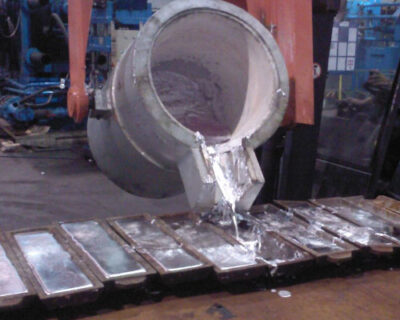Aluminum alloys are classified into deformed aluminum alloys and cast aluminum alloys according to their uses. Wrought aluminum alloys include daily-used aluminum alloy doors and windows, and space shuttle mechanism materials, which can be heat-treated or not heat-treated according to different usage requirements; the other type is cast aluminum alloys, mainly including aluminum-silicon alloys, aluminum-copper alloys, and aluminum-magnesium alloys, Aluminum-zinc alloy and aluminum rare-earth alloy, etc.
In the actual production process, cast aluminum alloys are classified according to the content of various chemical elements. The smelting process needs to add or reduce the amount of raw materials according to the actual chemical composition.
Using pure aluminum ingots as raw materials, the smelting process adjusts the chemical composition according to actual production needs. It can smelt different grades of aluminum alloy liquid, and can adapt to the needs of different products, with various product types. Before the aluminum alloy is smelted, the ingredients should be carried out according to the requirements. The ingredients should be based on the alloy grades, and the burning of various elements in the smelting process of the new material, the recycled material, and the master alloy needs to be considered.
The more economical and common smelting method in aluminum alloy smelting is gas furnace melting, which requires: fast melting, short time, and less air absorption. The order of feeding not only affects melting efficiency and alloy consumption, but also directly affects the quality of molten aluminum. The feeding principle is: first small, then large, first easy to melt and then hard to melt, first less burnt, then burnt easily, and finally deteriorate.

First add small pieces of reheating material, aluminum alloy ingots with lower melting point (such as Al-Si alloy), and then aluminum ingots with larger volume and higher melting point and intermediate alloys (such as Al-Mn), Mg, etc. are easy to burn The elements are added last. The small pieces of recycled material are first put at the bottom of the furnace to protect the furnace body and reduce the impact on the furnace wall when the large pieces of charge are charged. Also, because the recycled material has a low melting point and is easy to melt, the melting efficiency can be improved when the raw materials with higher melting points are subsequently melted. Add Mg to lower the temperature to reduce burn loss.
Melting is a process in which a solid heats up to become a liquid with fluidity. After the feeding is completed, the melting begins. During the smelting process, ensure that the melting is fast and uniform, and the temperature near the flame is higher, reaching 1200 ℃ or more. In order to avoid local overheating and high temperatures, serious oxidation of aluminum alloy will cause inconvenience to later product refining. Stirring should be carried out during the melting process, and the unmelted charge should be raked into the molten aluminum to make it almost completely immersed and stirred evenly to avoid local overheating. For the last immersed elements such as Mg, the flame cannot be directly heated and melted. Because the aluminum liquid is immersed in the raw materials, the temperature is lowered, and the elements such as Mg are kept to melt at a relatively low temperature, which reduces the burning loss and improves the combustion efficiency.
The aluminum alloy starts to melt at about 600 ℃, and the temperature is raised to 660 ℃ to melt completely, and the melting temperature is controlled not to exceed 760 ℃. When the melting temperature exceeds 770 ℃, the oxidation of aluminum alloy is serious, the hydrogen absorption and slag inclusion during the melting process increase, the crystal grains appear coarse during the casting and solidification process, and the mechanical properties are reduced. In order to reduce the oxidation of aluminum alloy in the melting process, 0.4% to 0.5% of the covering agent is added during the melting process to protect the aluminum alloy surface oxide film from being damaged. The type of covering agent is similar to the chemical composition of the cleaning agent.
The temperature of the smelting process is controlled at 720~760 ℃. After the part of the aluminum ingot is melted, raw materials with higher melting points such as Si and Ti are added. Ti forms heterogeneous nuclei in the alloy to refine the structure. It is pressed into the molten aluminum to melt and reduce burnout. After the aluminum ingot is basically melted, alloy elements such as Mg and Cu, which are easily burnt, are added. It cannot be added too early to reduce burning loss, nor too late to affect diffusion and segregation. Close the furnace door to continue smelting.

